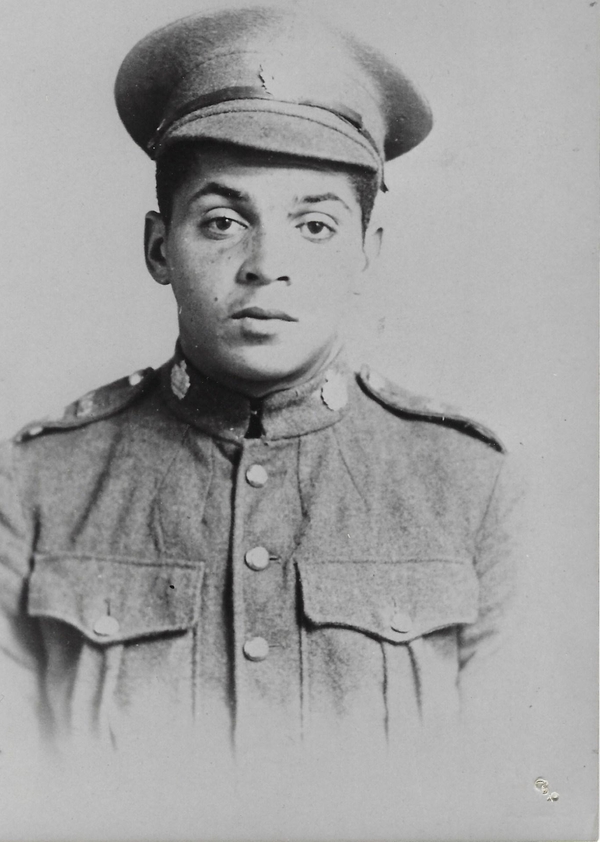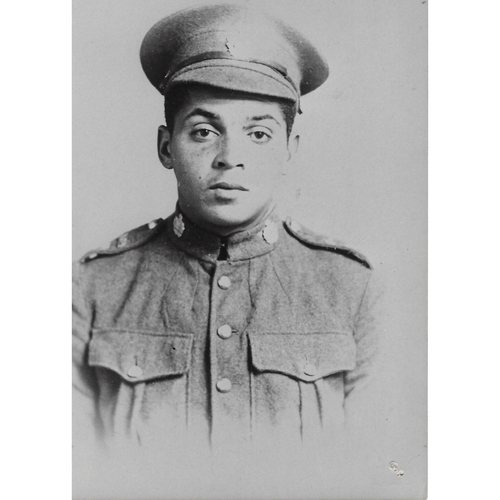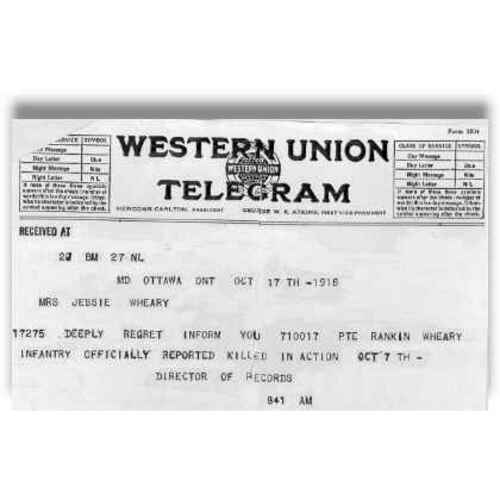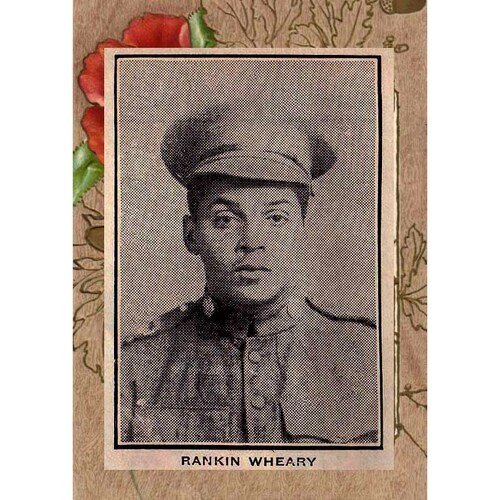
Source: Link
WHEARY, RANKIN, soldier; b. 10 Dec. 1895 in Woodstock, N.B., son of Wellington Wheary and Jessie McLaren; d. unmarried 7 Oct. 1918 near Cambrai, France.
Rankin Wheary was a young black man who served with the Canadian infantry in World War I. He was the product of a humble home: his father was a labourer whose grandfather had come to New Brunswick, probably with the loyalists; his mother was a domestic servant from Scotland. A year after his father’s death in 1911, Rankin left the College School in Woodstock and worked around town to help support his mother and younger sister. He then went off to war.
In turn-of-the-century Woodstock, a loyalist shire-town on the Saint John River, relations between whites and the small black community were friendly and segregation was not readily apparent. Baseball was popular and young Rankin took up the game with enthusiasm. He played schoolboy ball and then was a star pitcher and hitter for the Woodstock Federals, playing teams along the river valley and across the border in Maine. Baseball was also a popular and important recreational activity in the army, and Rankin played on the 104th Battalion and the 13th Reserve Battalion teams in England. After joining the 26th Battalion in France, he played shortstop on the regimental team, which won the 2nd Canadian Division championship in June 1918. One of his fellow soldiers in the 26th later recalled that “he was a marvel” on the baseball field.
The extent of service of individual black volunteers in front-line units of the Canadian Expeditionary Force has received only slight attention. Discrimination in the recruitment process and the oft-pronounced belief that “it was a white man’s war” have led to the assumption that few black recruits served in the army, let alone at the front. The prevailing view is that black soldiers were largely confined to the No.2 Construction Battalion, which was created to accept black volunteers. The experience of Rankin Wheary and others like him, however, suggests that the number of blacks in front-line units may have been much greater than is commonly believed.
As patriotic fervour to enlist swept the nation on Canada’s entry into the war, minority groups also offered their services [see Cameron Dee Brant; Yoichi Kamakura]. Although there were no official restrictions on black enlistments, local commanders were free to impose their own criteria and often refused fit black volunteers. When black spokesmen protested, the issue was handled awkwardly by the authorities: the army stated that there were no racial bars to service but local commanders remained free to choose recruits. The problem was highlighted in November 1915 by the rejection at Camp Sussex, N.B., of about 20 blacks who had arrived to join the 104th after enlisting in Saint John. Local protests led the Militia Council to repeat that “colored men are to be permitted to enlist in any battalion.” The problem persisted, however, and finally led to the establishment of the segregated No.2 Construction Battalion in July 1916.
Black volunteers had enlisted individually in New Brunswick from the beginning of the war. Their recruitment in Wheary’s home town was without incident and is perhaps illustrative of such quiet recruitment elsewhere. Even in Saint John, where discrimination was complained of before the war, blacks were accepted by local recruiting officials. Resistance to their service was met when they reported en masse to their unit but not, it appears, when they reported one by one.
Wheary had enlisted at Woodstock on 10 Jan. 1916 and two days later was taken on the strength of the 104th at Camp Sussex. He proceeded overseas and trained in England throughout the summer and fall. In December he was posted as a reinforcement to the 5th Canadian Mounted Rifles in France, joining his new regiment on 7 December. His service in the trenches over the next four months culminated in the battle of Vimy Ridge from 9 to 14 April 1917.
At the battle’s end Private Wheary reported sick with chilblains and trench fever. He was invalided back to England for treatment and convalescence. After being posted to the 13th Reserve Battalion in August, he returned to France in March 1918 and joined the 26th. From April through July this New Brunswick unit had seven tours in the trenches south of Arras followed by major actions at the battle of Amiens, the second battle of Arras in the approaches to the Drocourt-Quéant Line, and the battle of the Hindenburg Line at the Canal du Nord. On 7 Oct. 1918, when the battalion was preparing for the advance to Cambrai, Wheary was killed by enemy artillery fire near the town of Raillencourt. He is buried in Bourlon Wood Cemetery near Cambrai.
Such is the brief story of Rankin Wheary’s life. He was a popular young man in his home town and his regiments, similar to thousands of other young men who fought and died for king and country in the Great War. Although he left little behind except his memory, his army service is a pattern for individual black infantry recruits and illustrates the experience of the many black soldiers who volunteered and served without untoward racial incident in the CEF.
[Information concerning Rankin Wheary and the enlistment of blacks in Woodstock, N.B., was communicated to the author in telephone interviews with two former residents: Mrs Ypres [Dymond] Norton of Dartmouth, N.S., 3 and 8 May 1992, and the subject’s younger sister, the late Mrs Elsie [Wheary] Diggs of Windsor, Ont., 13 Dec. 1991 and 10 March 1992. j.l.w.]
Commonwealth War Graves Commission (Maidenhead, Eng.), Cemetery reg., index no.Fr.715 (Bourlon Wood Cemetery, France) (copy at the Commonwealth War Graves Commission, Canadian Agency, Ottawa). NA, RG 31, C1, 1851, 1861, 1871, 1881, 1891, 1901, Carleton and York counties, N.B. (mfm. at PANB); RG 150, Acc. 1992–93/166, file 710017. PANB, RS 141, B4, 9 March 1893; C4, 11 Jan. 1911; RS657, B3, College School (Woodstock), 1911. Private arch., J. L. Williamson (Fredericton), Letter from the adjutant general, director of records, to Jessie Wheary, 13 June 1919, with enclosure “Circumstances of death or missing report” (photocopy of original held by Mrs Diggs). Univ. of N.B. Library, Arch. and Special Coll. Dept. (Fredericton), MG H2 (Winslow papers). York Land Registry Office (Fredericton), Registry books (mfm. at PANB). Carleton Sentinel (Woodstock), 1909–18, 29 Sept. 1933. Dispatch (Woodstock), 1906–18. Saint John Globe, October–November 1915. St. John Standard (Saint John), October–November 1915. S. D. MacGowan et al., “New Brunswick’s ‘Fighting 26th’: a draft history of the 26th New Brunswick Battalion, C.E.F., 1914–1919” (typescript, 2v. in 1, Saint John, 1991; copy in Univ. of N.B. Library). C. W. Ruck, The black battalion, 1916–1920: Canada’s best kept military secret (rev. ed., Halifax, 1987). J. W. StG. Walker, “Race and recruitment in World War I: enlistment of visible minorities in the Canadian Expeditionary Force,” CHR, 70 (1989): 1–26; Racial discrimination in Canada: the black experience (Ottawa, 1985). R. W. Winks, The blacks in Canada: a history (Montreal, 1971).
Cite This Article
John L. Williamson, “WHEARY, RANKIN,” in Dictionary of Canadian Biography, vol. 14, University of Toronto/Université Laval, 2003–, accessed January 2, 2026, https://www.biographi.ca/en/bio/wheary_rankin_14E.html.
The citation above shows the format for footnotes and endnotes according to the Chicago manual of style (16th edition). Information to be used in other citation formats:
| Permalink: | https://www.biographi.ca/en/bio/wheary_rankin_14E.html |
| Author of Article: | John L. Williamson |
| Title of Article: | WHEARY, RANKIN |
| Publication Name: | Dictionary of Canadian Biography, vol. 14 |
| Publisher: | University of Toronto/Université Laval |
| Year of publication: | 1998 |
| Year of revision: | 1998 |
| Access Date: | January 2, 2026 |





